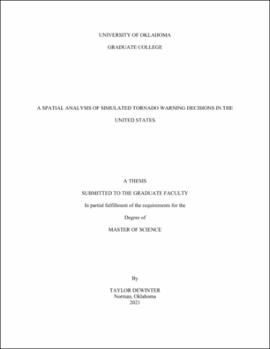| dc.description.abstract | The work presented in this thesis uses theories from risk perception and decision making to examine spatial variations of tornado warning decision making across the U.S. Decision-making as it relates to tornado warnings is heavily researched, yet many of these studies do not incorporate a spatial analysis of tornado warning decisions that compare individual responses across different geographical locations and populations. To address this research gap, this study uses data from a simulated tornado warning decision experiment, implemented nationwide, to examine demographic attributes that may influence incorrect decision making, how these attributes contribute to decision making across the U.S., and if there are broader regions in the U.S. that are hot spots for incorrect decision making. First, multilevel regression analysis and poststratification is used to (1) determine if there are certain demographic commonalities in people who are more prone to make incorrect decisions and (2) estimate what National Weather Service County Warning Areas are most associated with these populations. Second, the results of the multilevel regression analysis and poststratification are analyzed using spatial autocorrelation to identify if there are hot spots or regions where people tend to make more incorrect decisions in the decision experiment. Findings from this study show that gender, race, and ethnicity are important factors that influence incorrect decision making. Findings also consistently show that, though not statistically significant in most cases, the people across the southern U.S. tend to make more incorrect decisions, as defined in this work. This region tends to have high relative exposure to tornadoes. This study’s results have important implications because the demographic groups identified as making more incorrect decisions are also those groups that typically have higher social vulnerability than those who make fewer incorrect decisions. This work concludes with a summary of findings, avenues for future work, and recommendations for risk communicators. | en_US |
